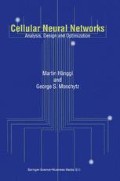Abstract
The applicability of CNNs in the areas of image and signal processing only becomes efficient if an appropriate analog hardware implementing the underlying network is available. Beside significant advantages of CNN chips over digital hardware such as processing speed, small size, and power consumption there is one severe drawback, namely their relatively poor accuracy. Robust operation can only be guaranteed for locally regular tasks, which makes local regularity a key concept for any practical applications of CNN chips:
-
• Locally regular tasks can be carried out on virtually all classes of CNN chip prototypes built so far, whether they are implemented as continuous-time or as sampled-data systems, and whether a saturation or a high-gain nonlinearity is used. They are also executable on cellular automata. Locally irregular tasks, however, are inherently sensitive and therefore not guaranteed to run reliably on an analog chip. Consequently, as long as the accuracy of the CNN circuitry is not substantially improved, the dynamics in the linear region cannot be fully exploited. From a practical point of view, it is sensible to design chips with the type of nonlinearity that is easiest to implement.
Access this chapter
Tax calculation will be finalised at checkout
Purchases are for personal use only
Author information
Authors and Affiliations
Editor information
Editors and Affiliations
Rights and permissions
Copyright information
© 2000 Springer Science+Business Media Dordrecht
About this chapter
Cite this chapter
Hänggi, M., Moschytz, G.S. (2000). Conclusions. In: Hänggi, M., Moschytz, G.S. (eds) Cellular Neural Networks. Springer, Boston, MA. https://doi.org/10.1007/978-1-4757-3220-7_7
Download citation
DOI: https://doi.org/10.1007/978-1-4757-3220-7_7
Publisher Name: Springer, Boston, MA
Print ISBN: 978-1-4419-4988-2
Online ISBN: 978-1-4757-3220-7
eBook Packages: Springer Book Archive

